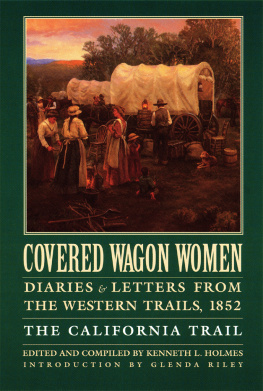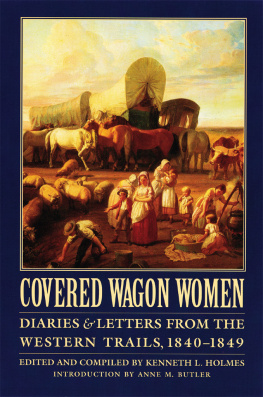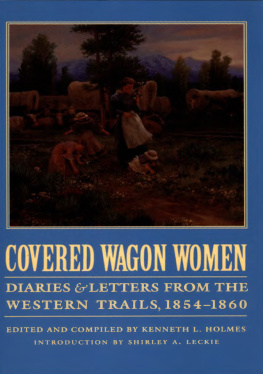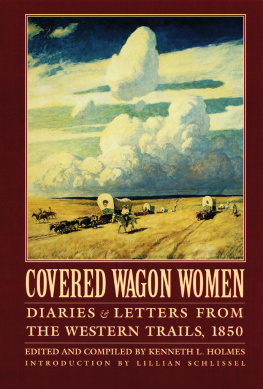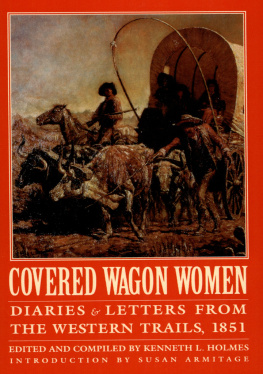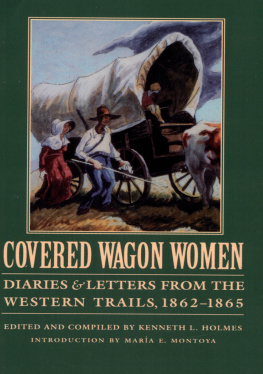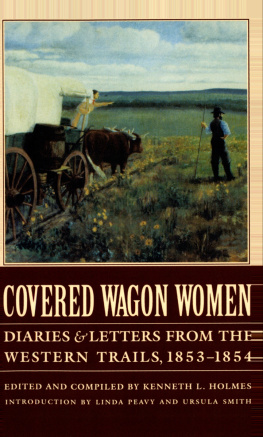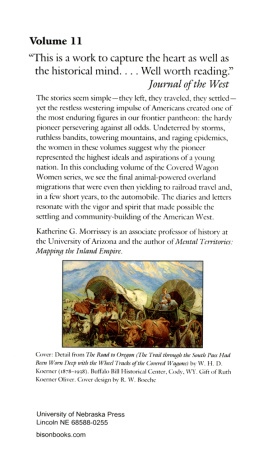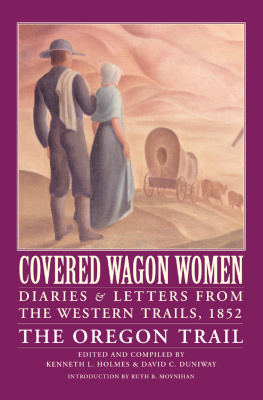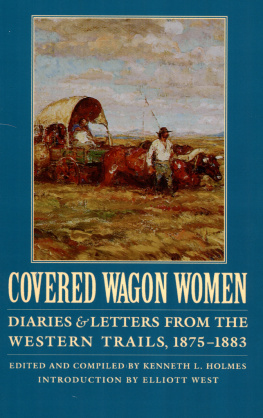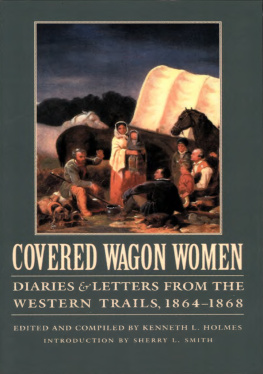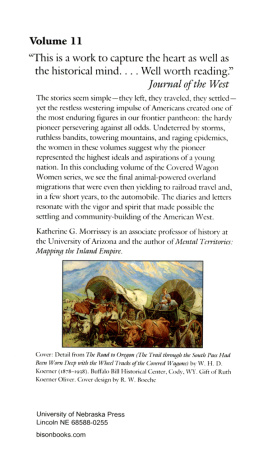Kenneth L. Holmes - Covered Wagon Women, Volume 4
Here you can read online Kenneth L. Holmes - Covered Wagon Women, Volume 4 full text of the book (entire story) in english for free. Download pdf and epub, get meaning, cover and reviews about this ebook. year: 2020, publisher: Bison Books, genre: Home and family. Description of the work, (preface) as well as reviews are available. Best literature library LitArk.com created for fans of good reading and offers a wide selection of genres:
Romance novel
Science fiction
Adventure
Detective
Science
History
Home and family
Prose
Art
Politics
Computer
Non-fiction
Religion
Business
Children
Humor
Choose a favorite category and find really read worthwhile books. Enjoy immersion in the world of imagination, feel the emotions of the characters or learn something new for yourself, make an fascinating discovery.
- Book:Covered Wagon Women, Volume 4
- Author:
- Publisher:Bison Books
- Genre:
- Year:2020
- Rating:3 / 5
- Favourites:Add to favourites
- Your mark:
- 60
- 1
- 2
- 3
- 4
- 5
Covered Wagon Women, Volume 4: summary, description and annotation
We offer to read an annotation, description, summary or preface (depends on what the author of the book "Covered Wagon Women, Volume 4" wrote himself). If you haven't found the necessary information about the book — write in the comments, we will try to find it.
Covered Wagon Women, Volume 4 — read online for free the complete book (whole text) full work
Below is the text of the book, divided by pages. System saving the place of the last page read, allows you to conveniently read the book "Covered Wagon Women, Volume 4" online for free, without having to search again every time where you left off. Put a bookmark, and you can go to the page where you finished reading at any time.
Font size:
Interval:
Bookmark:


 | 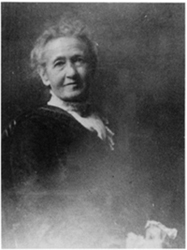 |
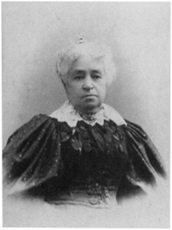 | Top left & right : Eliza Ann McAuley at |

1985 by Kenneth L. Holmes. Reprinted by arrangement with the Arthur H. Clark Company.
Introduction to the Bison Books Edition 1997 by the University of Nebraska Press
All rights reserved
Manufactured in the United States of America
The paper in this book meets the minimum requirements of American National Standard for Information Sciences-Permanence of Paper for Printed Library Materials, ANSI Z39.48-1984.
First Bison Books printing: 1997
Library of Congress Cataloging-in-Publication Data
The Library of Congress has cataloged Vol. 1 as:
Covered wagon women: diaries & letters from the western trails, 18401849 / edited and compiled by Kenneth L. Holmes; introduction to the Bison Books editon by Anne M. Butler.
p. cm.
Originally published: Glendale, Calif.: A. H. Clark Co., 1983.
Reprinted from volume one of the original eleven-volume edition
T.p. verso.
:Volume I.
Includes index.
ISBN 0-8032-7277-4 (pa: alk. paper)
ISBN 978-0-8032-7835 (epub)
ISBN 978-0-8032-7836-3 (mobi)
1. Women pioneersWest (U.S.)Biography. 2. West (U.S.)History.
3. West (U.S.)Biography. 4. Overland journeys to the Pacific.
5. Frontier and pioneer lifeWest (U.S.) I. Holmes, Kenneth L.
F591.C79 1996
978dc20 95-21200 CIP
Volume 2 introduction by Lillian Schlissel.
ISBN 0-8032-7274-X (pa: alk. paper)
Volume 3 introduction by Susan Armitage.
ISBN 0-8032-7287-1 (pa: alk. paper)
Volume 4 introduction by Glenda Riley.
ISBN 0-8032-729 I-X (pa: alk. paper)
Reprinted from volume four (1985) of the original eleven-volume edition titled Covered Wagon Women: Diaries and Letters from the Western Trails, 1840-1890 , by the Arthur H. Clark Company, Glendale, California.
The publisher does not have any control over and does not assume any responsibility for author or third-party websites or their content.
Introduction to the Bison Books Edition
Glenda Riley
During the past few years the concept of western trail has become increasingly complicated. Scholars have pointed out that numerous trails led to the American West, including a variety of overland routes, the trek across Panama, roads heading north from Mexico, and the Pacific and Atlantic oceans. These not only brought Anglo-Americans and African Americans westward, but Mexicans northward, and Europeans and Asians to the West.
This volume represents one of the most common routes: the one motion pictures and television have drawn upon for thousands of stories. The women who traversed the Oregon Trail, and offer their accounts here, were stock characters as well. They were largely Anglo-American and had a modicum of education, which allowed them to record their observations and experiences for posterity.
Because these women lacked exposure to television, especially the nightly news, they had little knowledge of other migrants taking different trails to a similar destination. In twentieth-century terms, they suffered from a want of global and cultural awareness. But, in nineteenth-century parlance, they had purpose.
For them, the trail was the Oregon Trail, invested with the demands, hardships, and adjustments they had to face to reach the far West. Despite the difficulties, thousands were willing to challenge the obstacles to finding new homes. In 1852, the number of migrants on the Oregon Trail increased notably over the previous year. The Missouri Republican of July 1, 1852, claimed that by May alone, 8,174 men, 1,286 women, and 1,776 children had departed for points west. The newspaper also commented that the migration included a marked increase in the number of women.
In the selections that follow, some of these women relate their reluctance to leave kin and friends behind, express their dread or curiosity about meeting their first Indian, wonder how they will survive striking climatic changes, and question their abilities to deal with natural and other disasters. They clearly anticipate the transformation of their known world.
Oregon Trail women were right to worry. Besides forsaking kin, friends, and others, they could expect to encounter peoples of vastly different cultures from their own. Moreover, before leaving home women absorbed confusing and conflicting images of Native Americans from the press and popular literature. On the one hand, Indians were seen as friendly, kind, and courageous; on the other, native peoples were described as bad, hostile, and vicious. Because the likeness of the bad Indian dominated during the l850s, however, women's initial expectations tended to be negative rather than positive.
Too, embellishments abounded at every turn. These included family stories about murderous savages, myths involving barbarians, and inflated rumors about Indian atrocities and uprisings. Along the trail, women encountered additional horror stories about Indian depredations and alarms of various sorts, including printed circulars and bleached skull bones inscribed dangerIndian troubles or Indian uprising, sometimes accompanied by a crude drawing of a skull and crossbones.
Presumably, Indians also heard rumors and gossip about the oncoming immigrants. Consequently, both sides were, at best, uninformedand, at worst, horribly misinformedabout the other. As Francis Sawyer put it, We are now in the Indian country, and we suspect that it will not be many days before we see some of these wild natives (89).
When they finally met, migrants and natives alike were primed for trouble. In addition, because meetings were unplanned and feared, no protocol for proper behavior existed. Both Anglos and Indians asked invasive questions, picked up and laughed at other peoples' possessions, and were curious to the point of rudeness. In some cases, anxiety and suspicion caused an encounter to turn into an armed confrontation. In other cases, people metand even likedeach other. Inevitably, however, some amount of conflict ensued, for settlers seemed intent on imposing their ways on American Indians. For example, even though most Indian cultures believed in sharing, Anglos tried to convince Native Americans that resources existed to be exploited. Women travelers had their own criticisms of Indians. They especially lamented the Indians' lack of clothing, inability to speak English, and practice of plural marriage.
Native peoples who resisted Anglo invasion and expressed their opinions about the changes occurring became, in Anglo eyes, savage, hostile, and barbaric. In one way, Indians were victims of encroaching settlers who tricked, cheated, and relied on the military to clear their way. In another, however, American Indians retained their dignity, if not their lands. In their own quiet fashion, Indians often expressed their wills. For instance, one traveler liked to tell the story of naive, childlike Indians who showed off by shooting arrows at nickels and other coins. Since the Indians kept the nickelsand spent them laterone has to wonder who was the gullible party.
Font size:
Interval:
Bookmark:
Similar books «Covered Wagon Women, Volume 4»
Look at similar books to Covered Wagon Women, Volume 4. We have selected literature similar in name and meaning in the hope of providing readers with more options to find new, interesting, not yet read works.
Discussion, reviews of the book Covered Wagon Women, Volume 4 and just readers' own opinions. Leave your comments, write what you think about the work, its meaning or the main characters. Specify what exactly you liked and what you didn't like, and why you think so.

